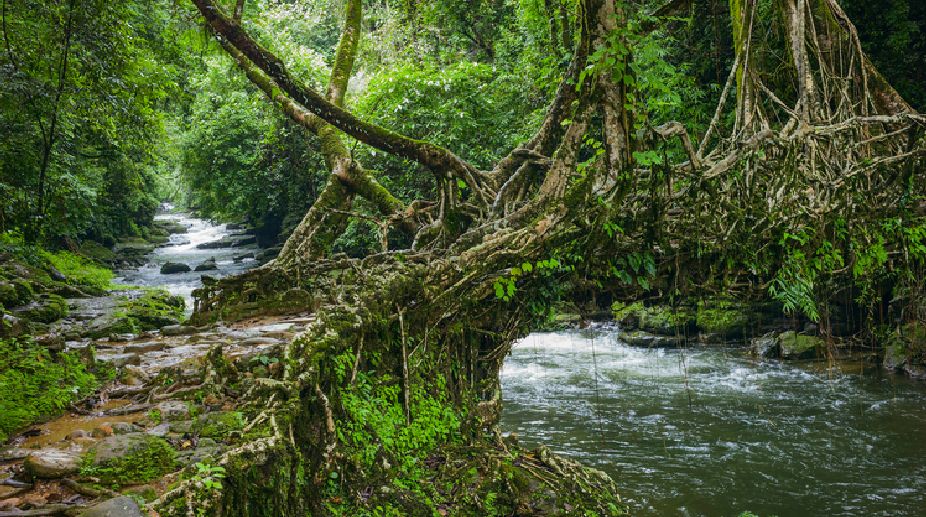Mawlynnong is utterly quiet when our hired cab pulls into the single main road of the village. It is just after lunch time; the tourist hordes have ticked this off their list and moved onto the next spot. “But what is there to see here?” A plaintive voice breaks the silence, asking a question often posed by eager visitors drawn here by the village’s distinctive identity.
Just a couple of hours out of Shillong, India’s unofficial rock and roll capital, located in its underexplored Northeast region, Mawlynnong was labelled “Asia’s cleanest village” by Discover India magazine in 2003, and various other publications since then, including the BBC and Lonely Planet.
Savvy locals, who recognised a business opportunity when they saw one, took this title to heart and turned their village into a tourism model for the entire country. Entrepreneurial spirit aside, as I talk to residents today I sense a genuine pride in this status.
At first glance there is nothing remarkable about Mawlynnong but then I start to notice the small things. The bamboo waste baskets lining the single main road of the village to ensure no littering. The old woman walking with a painful stoop, who bends downs to pick up a plastic wrapper someone has carelessly thrown away. The bamboo fences enclosing each house, with a neat garden and flowers in bloom.
The young boys and girls who take turns sweeping and cleaning the lanes and public spaces. By themselves these details are minor, but woven together they have created a village that is prettier than the average Indian one, replacing crowds and chaos with cleanliness and order.
My husband and I head up to the Sky View machan, a treehouse that sits 60ft in the air. By the time I’ve climbed to the top of the rickety bamboo staircase spreading across five different trees that leads to the machan, I feel a bit lightheaded.
“It’s 360 degrees!” local guide Henry Lyngdoh tells us at the top, waving his hands about expansively. It’s gorgeous up there, with views of the lush tree canopy below and the fertile plains of Bangladesh across the border. One moment it’s bright and sunny, and the next it suddenly buckets down, spoiling what could have been a perfect selfie situation. But then again, I am in Meghalaya, which means “the abode of clouds” in Sanskrit.
The state is home to Cherrapunjee and Mawsynram, both of which lay claim to being the wettest places on earth. However, clean roads and tree houses are not the real reason I’ve come to Mawlynnong. I’m here to see Meghalaya’s unique “living root bridges”.
For several decades now, locals in the interiors of the state don’t build artificial bridges across water — they grow them by spinning the roots of the strong Ficus Elastica (rubber tree), nurture them till they form a natural bridge spanning the entire distance, and reinforce them with stones and boulders. These bridges only become stronger over time, carrying up to 50 adults at a go, never getting weakened by forces of nature; crucial in this rain-rich territory where the gentlest stream can turn into a ferocious torrent overnight.
Meghalaya’s most famous one is the 180-year-old double-decker bridge at Nongriat close to Cherrapunjee, but that can be reached only after a tough trek involving ups and downs over hundreds of steps in the forest. We opt for one right next to Mawlynnong, not quite so popular but more easily accessible. We head to Riwai village early the next morning to beat the tourist hordes.
The bridge is every bit as captivating as I expected it to be, entirely woven out of tree branches and roots, swaying ever so gently as we take tentative steps over the uneven surface.
A couple of giggly schoolgirls skip past us, pigtails waving in the morning breeze. We cross the bridge and find a quiet spot downstream. We are the only two tourists there, apart from the local women who line up to wash themselves and their clothes in an established daily morning ritual. I am in a slightly mellow and introspective mood as I watch the mild morning sunlight glint off the root bridge onto the water.
These wise locals in the middle of nowhere have been working in harmony with nature for years now instead of fighting its might. Surely there’s a lesson somewhere in that for all of us? (The Independent)










